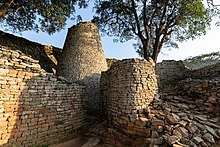 Tower in the Great Enclosure, Great Zimbabwe | |
| Location | Masvingo Province, Zimbabwe |
|---|---|
| Coordinates | 20°16′S 30°56′E / 20.267°S 30.933°E |
| Type | Settlement |
| Part of | Kingdom of Zimbabwe |
| Area | 7.22 km2 (2.79 sq mi) |
| History | |
| Material | Granite |
| Founded | 11th century CE |
| Abandoned | 15th century CE |
| Periods | Late Iron Age |
| Cultures | Kingdom of Zimbabwe |
| Official name | Great Zimbabwe National Monument |
| Criteria | Cultural: i, iii, vi |
| Reference | 364 |
| Inscription | 1986 (10th Session) |
Great Zimbabwe is a medieval city in the south-eastern hills of the modern country of Zimbabwe, near Lake Mutirikwe and the town of Masvingo. It was the capital of the Kingdom of Zimbabwe from the 13th century, having been settled in the 4th century AD.[1] Construction on the city began in the 11th century and continued until it was abandoned in the 15th century.[2][3][4] The edifices were erected by ancestors of the Shona people, currently located in Zimbabwe and nearby countries.[5] The stone city spans an area of 7.22 square kilometres (2.79 sq mi) and could have housed up to 18,000 people at its peak, giving it a population density of approximately 2,500 inhabitants per square kilometre (6,500/sq mi). It is recognised as a World Heritage Site by UNESCO.
Great Zimbabwe is believed to have served as a royal palace for the local monarch. As such, it would have been used as the seat of political power. Among the edifice's most prominent features were its walls, some of which are 11 metres (36 ft) high.[5] They were constructed of "dry stone" (that is, without mortar). Eventually, the city was abandoned and fell into ruin.
The earliest document mentioning the Great Zimbabwe ruins was in 1531 by Vicente Pegado, captain of the Portuguese garrison of Sofala on the coast of modern-day Mozambique, who recorded it as Symbaoe. The first confirmed visits by Europeans were in the late 19th century, with investigations of the site starting in 1871.[6] Some later studies of the monument were controversial, as the white government of Rhodesia pressured archeologists to deny its construction by black Africans.[7] Great Zimbabwe has since been adopted as a national monument by the Zimbabwean government, and the modern independent state was named after it.
The word great distinguishes the site from the many smaller ruins, now known as "zimbabwes", spread across the Zimbabwe Highveld.[8] There are 200 such sites in southern Africa, such as Bumbusi in Zimbabwe and Manyikeni in Mozambique, with monumental, mortarless walls.[9]
- ^ Pikirayi, Innocent (2013). "Great Zimbabwe in Historical Archaeology: Reconceptualizing Decline, Abandonment, and Reoccupation of an Ancient Polity, A.D. 1450–1900". Historical Archaeology. 47: 26–37. doi:10.1007/BF03376887. hdl:2263/59176. S2CID 59380130.
- ^ Pikirayi, Innocent; Sulas, Federica; Chirikure, Shadreck; Chikumbirike, Joseph; Sagiya, Munyaradzi Elton (January 2023). "The Conundrum of Great Zimbabwe". Journal of Urban Archaeology. 7: 95–114. doi:10.1484/J.JUA.5.133452. ISSN 2736-2426. Retrieved 1 December 2023.
- ^ Cite error: The named reference
currentwas invoked but never defined (see the help page). - ^ Cite error: The named reference
MMAwas invoked but never defined (see the help page). - ^ a b "Great Zimbabwe: African City of Stone". Live Science. 10 March 2017.
- ^ Fleminger, David (2008). Mapungubwe Cultural Landscape. 30 Degrees South. p. 57. ISBN 978-0-9584891-5-7.
- ^ Frederikse, Julie (1990) [1982]. "(1) Before the war". None But Ourselves. Biddy Partridge (photographer). Harare: Oral Traditions Association of Zimbabwe with Anvil Press. pp. 10–11. ISBN 0-7974-0961-0.
- ^ M. Sibanda, H. Moyana et al. 1992. The African Heritage. History for Junior Secondary Schools. Book 1. Zimbabwe Publishing House. ISBN 978-0-908300-00-6
- ^ Cite error: The named reference
antiquitywas invoked but never defined (see the help page).

